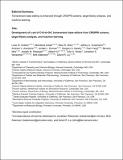Development of a set of C•G-to-G•C transversion base editors from CRISPRi screens, target-library analysis, and machine learning
Author(s)
Koblan, Luke W.; Arbab, Mandana; Shen, Max Walt; Hussmann, Jeffrey A.; Anzalone, Andrew V.; Doman, Jordan L; Newby, Gregory Arthur; Yang, Dian; Mok, Beverly; Replogle, Joseph M.; Xu, Albert; Sisley, Tyler A.; Weissman, Jonathan S.; Adamson, Britt; Liu, David R.; ... Show more Show less
DownloadAccepted version (10.15Mb)
Open Access Policy
Open Access Policy
Creative Commons Attribution-Noncommercial-Share Alike
Alternative title
Efficient C•G-to-G•C base editors developed using CRISPRi screens, target-library analysis, and machine learning
Terms of use
Metadata
Show full item recordAbstract
Programmable C•G-to-G•C base editors (CGBEs) have broad scientific and therapeutic potential, but their editing outcomes have proved difficult to predict and their editing efficiency and product purity are often low. We describe a suite of engineered CGBEs paired with machine learning models to enable efficient, high-purity C•G-to-G•C base editing. We performed a CRISPR interference (CRISPRi) screen targeting DNA repair genes to identify factors that affect C•G-to-G•C editing outcomes and used these insights to develop CGBEs with diverse editing profiles. We characterized ten promising CGBEs on a library of 10,638 genomically integrated target sites in mammalian cells and trained machine learning models that accurately predict the purity and yield of editing outcomes (R = 0.90) using these data. These CGBEs enable correction to the wild-type coding sequence of 546 disease-related transversion single-nucleotide variants (SNVs) with >90% precision (mean 96%) and up to 70% efficiency (mean 14%). Computational prediction of optimal CGBE-single-guide RNA pairs enables high-purity transversion base editing at over fourfold more target sites than achieved using any single CGBE variant.
Date issued
2021-06Department
Massachusetts Institute of Technology. Department of Biology; Massachusetts Institute of Technology. Department of Chemistry; Massachusetts Institute of Technology. Computational and Systems Biology ProgramJournal
Nature Biotechnology
Publisher
Springer Science and Business Media LLC
Citation
Koblan, Luke W. et al. "Development of a set of C•G-to-G•C transversion base editors from CRISPRi screens,
target-library analysis, and machine learning." Nature Biotechnology (June 2021): dx.doi.org/10.1038/s41587-021-00938-z. © 2021 The Author(s)
Version: Author's final manuscript
ISSN
1087-0156
1546-1696